-
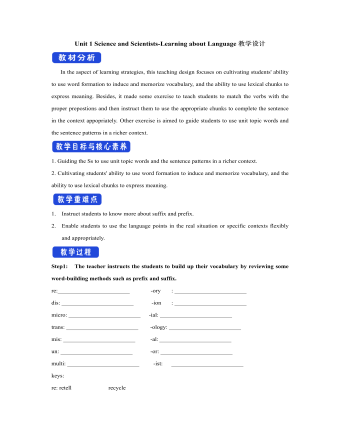
新人教版高中英语选修2Unit 1 Science and Scientists-Learning about Language教学设计
Step 7: complete the discourse according to the grammar rules.Cholera used to be one of the most 1.__________ (fear) diseases in the world. In the early 19th century, _2_________ an outbreak of cholera hit Europe, millions of people died. But neither its cause, 3__________ its cure was understood. A British doctor, John Snow, wanted to solve the problem and he knew that cholera would not be controlled _4_________ its cause was found. In general, there were two contradictory theories 5 __________ explained how cholera spread. The first suggested that bad air caused the disease. The second was that cholera was caused by an _6_________(infect) from germs in food or water. John Snow thought that the second theory was correct but he needed proof. So when another outbreak of cholera hit London in 1854, he began to investigate. Later, with all the evidence he _7_________ (gather), John Snow was able to announce that the pump water carried cholera germs. Therefore, he had the handle of the pump _8_________ (remove) so that it couldn't be used. Through his intervention,the disease was stopped in its tracks. What is more, John Snow found that some companies sold water from the River Thames that __9__________________ (pollute) by raw waste. The people who drank this water were much more likely _10_________ (get) cholera than those who drank pure or boiled water. Through John Snow's efforts, the _11_________ (threaten) of cholera around the world saw a substantial increase. Keys: 1.feared 2.when 3. nor 4.unless 5.that/which 6.infection 7.had gathered 8.removed 9.was polluted 10.to get 11. threat
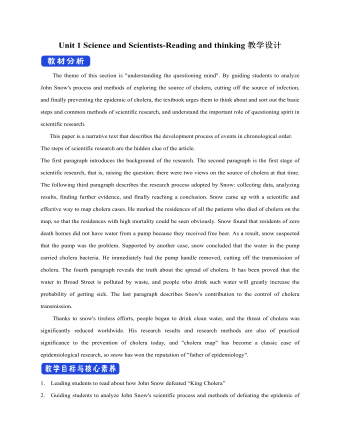
新人教版高中英语选修2Unit 1 Science and Scientists-Reading and thinking教学设计
Step 5: After learning the text, discuss with your peers about the following questions:1.John Snow believed Idea 2 was right. How did he finally prove it?2. Do you think John Snow would have solved this problem without the map?3. Cholera is a 19th century disease. What disease do you think is similar to cholera today?SARS and Covid-19 because they are both deadly and fatally infectious, have an unknown cause and need serious public health care to solve them urgently.keys:1. John Snow finally proved his idea because he found an outbreak that was clearly related to cholera, collected information and was able to tie cases outside the area to the polluted water.2. No. The map helped John Snow organize his ideas. He was able to identify those households that had had many deaths and check their water-drinking habits. He identified those houses that had had no deaths and surveyed their drinking habits. The evidence clearly pointed to the polluted water being the cause.3. SARS and Covid-19 because they are both deadly and fatally infectious, have an unknown cause and need serious public health care to solve them urgently.Step 6: Consolidate what you have learned by filling in the blanks:John Snow was a well-known _1___ in London in the _2__ century. He wanted to find the _3_____ of cholera in order to help people ___4_____ it. In 1854 when a cholera __5__ London, he began to gather information. He ___6__ on a map ___7___ all the dead people had lived and he found that many people who had ___8____ (drink) the dirty water from the __9____ died. So he decided that the polluted water ___10____ cholera. He suggested that the ___11__ of all water supplies should be _12______ and new methods of dealing with ____13___ water be found. Finally, “King Cholera” was __14_____.Keys: 1. doctor 2. 19th 3.cause 4.infected with 5.hit 6.marked 7.where 8.drunk 9.pump 10.carried 11.source 12.examined 13.polluted 14.defeatedHomework: Retell the text after class and preview its language points
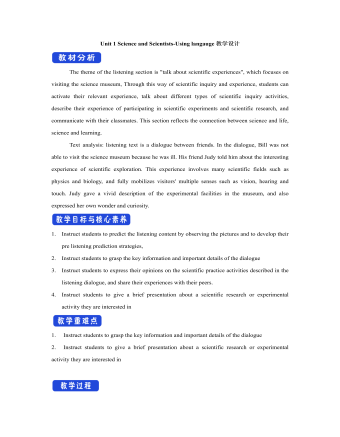
新人教版高中英语选修2Unit 1 Science and Scientists-Using langauge教学设计
This happens because the dish soap molecules have a strong negative charge, and the milk molecules have a strong positive charge. Like magnets, these molecules are attracted to each other, and so they appear to move around on the plate, taking the food coloring with them, making it look like the colors are quickly moving to escape from the soap.Listening text:? Judy: Oh, I'm so sorry that you were ill and couldn't come with us on our field trip. How are you feeling now? Better?? Bill: Much better, thanks. But how was it?? Judy: Wonderful! I especially liked an area of the museum called Light Games.it was really cool. They had a hall of mirrors where I could see myself reflected thousands of times!? Bill: A hall of mirrors can be a lot of fun. What else did they have?? Judy: Well, they had an experiment where we looked at a blue screen for a while, and then suddenly we could see tiny bright lights moving around on it. You'll never guess what those bright lights were!? Bill: Come on, tell me!? Judy: They were our own blood cells. For some reason, our eyes play tricks on us when we look at a blue screen, and we can see our own blood cells moving around like little lights! But there was another thing I liked better. I stood in front of a white light, and it cast different shadows of me in every color of the rainbow!? Bill: Oh, I wish I had been there. Tell me more!? Judy: Well, they had another area for sound. They had a giant piano keyboard that you could use your feet to play. But then, instead of playing the sounds of a piano, it played the voices of classical singers! Then they had a giant dish, and when you spoke into it, it reflected the sound back and made it louder. You could use it to speak in a whisper to someone 17 meters away.? Bill: It all sounds so cool. I wish I could have gone with you? Judy: I know, but we can go together this weekend. I'd love to go there again!? Bill: That sounds like a great idea!
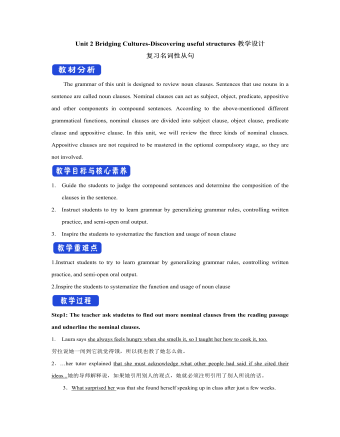
新人教版高中英语选修2Unit 2 Bridging Cultures-Discovering useful structures教学设计
The grammar of this unit is designed to review noun clauses. Sentences that use nouns in a sentence are called noun clauses. Nominal clauses can act as subject, object, predicate, appositive and other components in compound sentences. According to the above-mentioned different grammatical functions, nominal clauses are divided into subject clause, object clause, predicate clause and appositive clause. In this unit, we will review the three kinds of nominal clauses. Appositive clauses are not required to be mastered in the optional compulsory stage, so they are not involved.1. Guide the students to judge the compound sentences and determine the composition of the clauses in the sentence.2. Instruct students to try to learn grammar by generalizing grammar rules, controlling written practice, and semi-open oral output.3. Inspire the students to systematize the function and usage of noun clause1.Instruct students to try to learn grammar by generalizing grammar rules, controlling written practice, and semi-open oral output.2.Inspire the students to systematize the function and usage of noun clauseStep1: The teacher ask studetns to find out more nominal clauses from the reading passage and udnerline the nominal clauses.
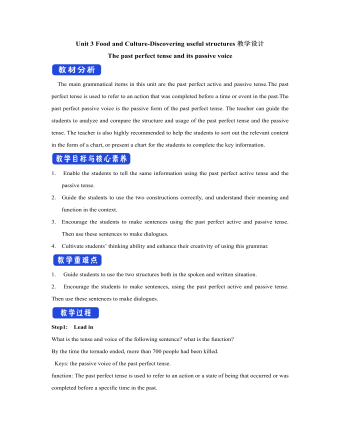
新人教版高中英语选修2Unit 3 Food and Culture-Discovering useful structures教学设计
The newspaper reported more than 100 people had been killed in the thunderstorm.报纸报道说有一百多人在暴风雨中丧生。(2)before、when、by the time、until、after、once等引导的时间状语从句的谓语是一般过去时,以及by、before后面接过去的时间时,主句动作发生在从句的动作或过去的时间之前且表示被动时,要用过去完成时的被动语态。By the time my brother was 10, he had been sent to Italy.我弟弟10岁前就已经被送到意大利了。Tons of rice had been produced by the end of last month. 到上月底已生产了好几吨大米。(3) It was the first/second/last ... time that ...句中that引导的定语从句中,主语与谓语构成被动关系时,要用过去完成时的被动语态。It was the first time that I had seen the night fact to face in one and a half years. 这是我一年半以来第一次亲眼目睹夜晚的景色。(4)在虚拟语气中,条件句表示与过去事实相反,且主语与谓语构成被动关系时,要用过去完成时的被动语态。If I had been instructed by him earlier, I would have finished the task.如果我早一点得到他的指示,我早就完成这项任务了。If I had hurried, I wouldn't have missed the train.如果我快点的话,我就不会误了火车。If you had been at the party, you would have met him. 如果你去了晚会,你就会见到他的。

新人教版高中英语选修2Unit 3 Food and Culture-Reading and thinking教学设计
The discourse explores the link between food and culture from a foreign’s perspective and it records some authentic Chinese food and illustrates the cultural meaning, gerography features and historic tradition that the food reflects. It is aimed to lead students to understand and think about the connection between food and culture. While teaching, the teacher should instruct students to find out the writing order and the writer’s experieces and feelings towards Chinese food and culture.1.Guide the students to read the text, sort out the information and dig out the topic.2.Understand the cultural connotation, regional characteristics and historical tradition of Chinese cuisine3.Understand and explore the relationship between food and people's personality4.Guide the students to use the cohesive words in the text5.Lead students to accurately grasp the real meaning of the information and improve the overall understanding ability by understanding the implied meaning behind the text.1. Enable the Ss to understand the structure and the writing style of the passage well.2. Lead the Ss to understand and think further about the connection between food and geography and local character traits.Step1: Prediction before reading. Before you read, look at the title, and the picture. What do you think this article is about?keys:It is about various culture and cuisine about a place or some countries.
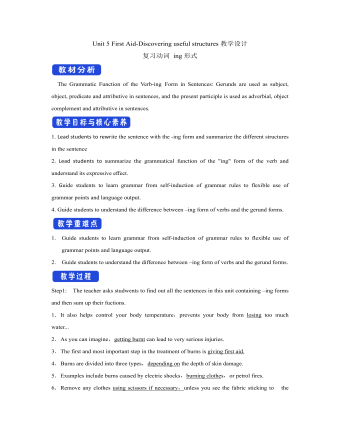
新人教版高中英语选修2Unit 5 First Aid-Discovering useful structures教学设计
You have no excuse for not going.你没有理由不去。He was punished for not having finished his homework.他因未完成作业而受到惩罚。2.动词ing形式复合结构由物主代词或人称代词宾格、名词所有格或普通格加动词ing,即“sb./sb.'s+doing”构成。动词ing形式的复合结构实际上是给动词ing形式加了一个逻辑主语。动词ing形式的复合结构有四种形式:①形容词性物主代词+动词ing②名词所有格+动词ing③代词宾格+动词ing④名词+动词ingHer coming to help encouraged all of us.她来帮忙鼓舞了我们所有人。The baby was made awake by the door suddenly shutting.这个婴儿被突然的关门声吵醒了。Can you imagine him/Jack cooking at home?你能想象他/杰克在家做饭的样子吗?无生命名词无论是作主语还是作宾语都不能用第②种形式。Tom's winning first prize last year impressed me a lot.汤姆去年得了一等奖使我印象深刻。Do you mind my/me/Jack's/Jack leaving now?你介意我/杰克现在离开吗?Excuse me for my not coming on time.很抱歉我没能按时来。His father's being ill made him worried.他父亲病了,他很担心。We are looking forward to the singer's/the singer to give us a concert.我们盼望着这位歌手来给我们举办一场演唱会。
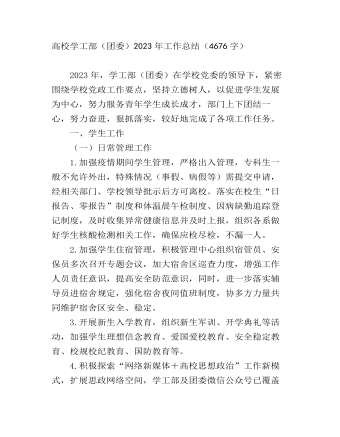
高校学工部(团委)2023年工作总结
一、学生工作(一)日常管理工作1.加强疫情期间学生管理,严格出入管理,专科生一般不允许外出,特殊情况(事假、病假等)需提交申请,经相关部门、学校领导批示后方可离校。落实在校生“日报告、零报告”制度和体温晨午检制度、因病缺勤追踪登记制度,及时收集异常健康信息并及时上报,组织各系做好学生核酸检测相关工作,确保应检尽检,不漏一人。2.加强学生住宿管理,积极管理中心组织宿管员、安保员多次召开专题会议,加大宿舍区巡查力度,增强工作人员责任意识,提高安全防范意识,同时,进一步落实辅导员进宿舍规定,强化宿舍夜间值班制度,协多方力量共同维护宿舍区安全、稳定。3.开展新生入学教育,组织新生军训、开学典礼等活动,加强学生理想信念教育、爱国爱校教育、安全稳定教育、校规校纪教育、国防教育等。4.积极探索“网络新媒体+高校思想政治”工作新模式,扩展思政网络空间,学工部及团委微信公众号已覆盖全体在校生,其中,学工部微平台设立了“国奖人物”、迎新指南等板块,宣扬榜样力量,强化爱国教育、营造积极向上的校园氛围。团委微平台设立了团团快讯、青年之声等板块,立足宣传、发声的功能定位,着力提升网络舆论引导的影响力、引领力。
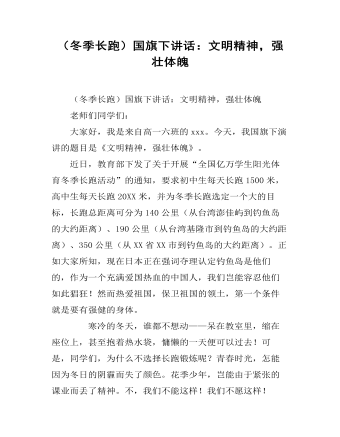
(妇女节)国旗下讲话:学会感恩
“感恩的心,感谢有你,伴我一生,让我有勇气做我自己;感恩的心,感谢命运,花开花落,我一样会珍惜……”熟悉的旋律,每天在校园响起。同学们,当你听到这首歌时,请你问问自己,我会感恩吗?当我们第一次懂得凝望这个多彩的世界,是母亲的双眸与臂弯让我们温暖满怀;当我们咿呀学语,能喊出的第一个字眼是妈妈;当我们蹒跚学步,直至独立行走的背后,又是父母多少的担惊受怕;当我们迈进学校,吮吸知识的甘露时,是老师无怨无悔的辛勤付出。老师——妈妈,妈妈——老师!在我们成长的道路上,是你们给了我们太多太多的爱。学会感恩,课上专心听讲,认真思考,主动的参与,努力的进步;学会感恩,听从父母的教导,与父母发生分歧时,不赌气,多沟通,帮助父母做力所能及的家务。这样,你就会发现老师、父母脸上多出的那一份欣慰的笑容。
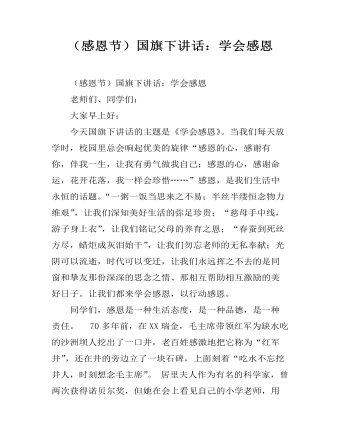
(感恩节)国旗下讲话:学会感恩
今天国旗下讲话的主题是《学会感恩》。当我们每天放学时,校园里总会响起优美的旋律“感恩的心,感谢有你,伴我一生,让我有勇气做我自己;感恩的心,感谢命运,花开花落,我一样会珍惜……”感恩,是我们生活中永恒的话题。“一粥一饭当思来之不易;半丝半缕恒念物力维艰”,让我们深知美好生活的弥足珍贵;“慈母手中线,游子身上衣”,让我们铭记父母的养育之恩;“春蚕到死丝方尽,蜡炬成灰泪始干”,让我们勿忘老师的无私奉献;光阴可以流逝,时代可以变迁,让我们永远挥之不去的是同窗和挚友那份深深的思念之情、那相互帮助相互激励的美好日子。让我们都来学会感恩,以行动感恩。同学们,感恩是一种生活态度,是一种品德,是一种责任。 70多年前,在XX瑞金,毛主席带领红军为缺水吃的沙洲坝人挖出了一口井,老百姓感激地把它称为“红军井”,还在井的旁边立了一块石碑,上面刻着“吃水不忘挖井人,时刻想念毛主席”。 居里夫人作为有名的科学家,曾两次获得诺贝尔奖,但她在会上看见自己的小学老师,用一束鲜花表达她的感激之情;伟人毛泽东也同样在佳节送上对老师的一份深深感激。自古以来的伟人无不有着一颗感恩的心。
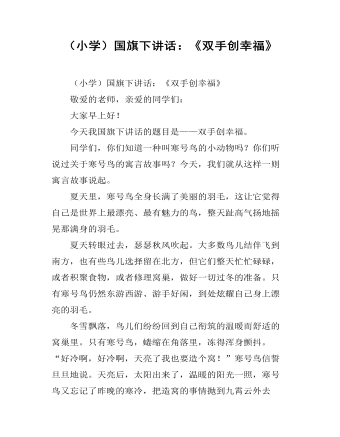
(小学)国旗下讲话:《双手创幸福》
就这样,寒号鸟每晚都在立志,白天又不去劳动,一个冬天过去了,窝始终没有建起来,最终冻死在岩石缝里。这则寓言告诉我们,劳动是生活的基础,是幸福的。人生中,既要有仰望星空的志向,更要付诸脚踏实地的劳动。同学们,让我们用双手创造幸福,用劳动践行理想吧!谢谢大家!

(小学)国旗下讲话:播种在春天
同学们,当冬日的寒冷渐渐退去,当花草的馨香再次飘起,我们带着希望,带着憧憬,怀着激动,怀着兴奋,迎来了一个崭新的春天。俗话说:一年之计在于春。我们在春天里播撒文明、勤奋、乐学、健康、合作的种子,秋天里就会收获明礼诚信、乐学善思、身心健康、团结合作的丰硕成果。成功的结果于点滴的过程,在这个播种的季节,我们要做到以下几点:首先,讲文明、有礼貌。把“请”、“您好”、“对不起”、“没关系”这些礼貌用语用在我们的日常生活中,努力做到同学之间团结友善,让关爱和谐的氛围萦绕在我们周围。
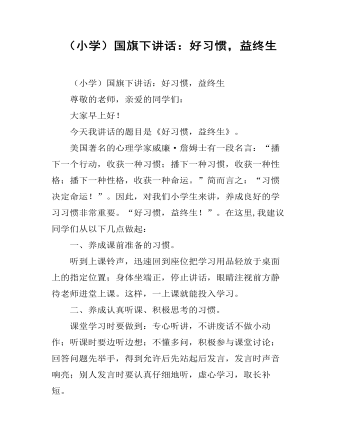
(小学)国旗下讲话:好习惯,益终生
三、养成预习、复习的习惯。每天都要把学过的知识复习巩固,还要对明天要学习的内容进行预习,把不懂的问题记下来。四、养成独立作业与检查订正的习惯。尽量在一个安静的环境中积极独立思考,完成作业。做好后仔细检查;作业本发下后发现答错题自觉及时地订正。五、养成课外阅读习惯。课外多阅读,可以开拓视野,丰富知识,提高表达与写作能力。如果你养成了以上的学习习惯,每天一定会有新的收获!同学们,让我们从现在做起,从点滴做起,不断坚持,逐渐养成良好的学习习惯,做一名勤学、乐学、善学的好学生!谢谢大家!
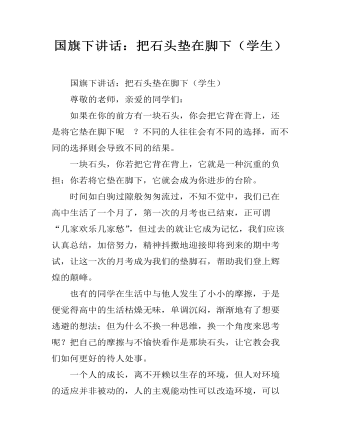
国旗下讲话:把石头垫在脚下(学生)
尊敬的老师,亲爱的同学们:如果在你的前方有一块石头,你会把它背在背上,还是将它垫在脚下呢 ?不同的人往往会有不同的选择,而不同的选择则会导致不同的结果。一块石头,你若把它背在背上,它就是一种沉重的负担;你若将它垫在脚下,它就会成为你进步的台阶。时间如白驹过隙般匆匆流过,不知不觉中,我们已在高中生活了一个月了,第一次的月考也已结束,正可谓“几家欢乐几家愁”,但过去的就让它成为记忆,我们应该认真总结,加倍努力,精神抖擞地迎接即将到来的期中考试,让这一次的月考成为我们的垫脚石,帮助我们登上辉煌的颠峰。也有的同学在生活中与他人发生了小小的摩擦,于是便觉得高中的生活枯燥无味,单调沉闷,渐渐地有了想要逃避的想法;但为什么不换一种思维,换一个角度来思考呢?
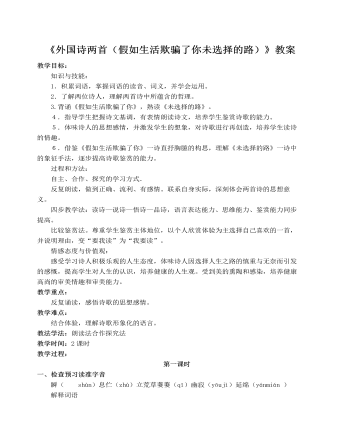
部编版语文七年级下册《外国诗两首(假如生活欺骗了你 未选择的路)》教案
写作背景这首诗写于普希金被沙皇流放的日子里,是以赠诗的形式写在他的邻居奥希泊娃的女儿叶甫勃拉克西亚·尼古拉耶夫娜·伏里夫纪念册上的。那里俄国革命正如火如荼,诗人却被迫与世隔绝。在这样的处境下,诗人却没有丧失希望与斗志,他热爱生活,执着地追求理想,相信光明必来,正义必胜。(三)、问题探究1、“假如生活欺骗了你”指的是什么?指在生活中因遭遇艰难困苦甚至不幸而身处逆境。作者写这首诗时正被流放,是自己真实生活的写照。2、诗人在诗中阐明了怎样的人生态度?请结合你感受最深的诗句说说你曾有过的体验。诗中阐明了这样一种积极乐观的人生态度:当生活欺骗了你时,不要悲伤,不要心急;在苦恼的时候要善于忍耐,一切都会过去,我们一定要永葆积极乐观的心态;生活中不可能没有痛苦与悲伤,欢乐不会永远被忧伤所掩盖,快乐的日子终会到来。
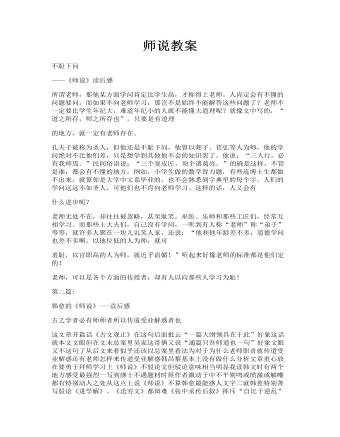
师说教案
孔夫子被称为圣人,但他还是不耻下问,他曾以郯子、苌弘等人为师,他的学问绝对不比他们差,只是想学到其他他不会的知识罢了。他说:“三人行,必有我师焉。”民间俗语说:“三个臭皮匠,顶个诸葛亮。”的确是这样,不管是谁,都会有不懂的地方,例如,小学生做的数学智力题,有些连博士生都做不出来,就算你是大学中文系毕业的,也不会熟悉到字典里的每个字。人们的学问远远不如圣人,可他们也不肯向老师学习。这样的话,人又会有什么进步呢?老师无处不在,却往往被忽略,甚至耻笑。巫医、乐师和那些工匠们,经常互相学习。而那些士大夫们,自己没有学问,一听到有人称“老师”称“弟子”等等,就许多人聚在一块儿讥笑人家,还说:“他和他年龄差不多,道德学问也差不多啊,以地位低的人为师,就可羞耻,以官职高的人为师,就近乎谄媚!”听起来好像老师的标准都是他们定的!老师,可以是各个方面的传授者,却有人以向那些人学习为耻!
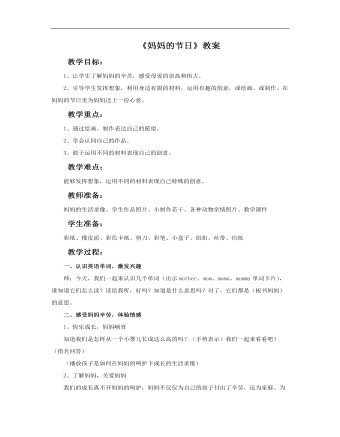
小学美术人教版一年级下册《第12课妈妈的节日》教案
教学重点:1、通过绘画、制作表达自己的愿望。2、学会认同自己的作品。3、敢于运用不同的材料表现自己的创意。教学难点:能够发挥想象,运用不同的材料表现自己特殊的创意。教师准备:妈妈的生活录像、学生作品照片、小制作若干、各种动物亲情照片、教学课件学生准备:彩纸、橡皮泥、彩色卡纸、剪刀、彩笔、小盒子、纽扣、丝带、信纸
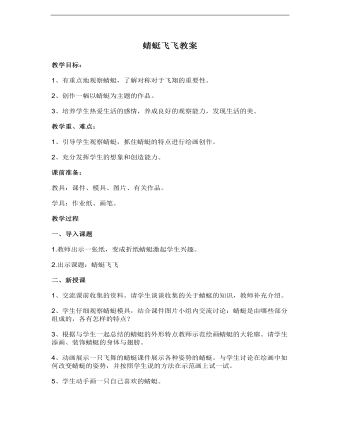
小学美术人教版二年级上册《第9课蜻蜓飞飞》教案说课稿
1、引导学生观察蜻蜓,抓住蜻蜓的特点进行绘画创作。2、充分发挥学生的想象和创造能力。课前准备:教具:课件、模具、图片、有关作品。学具:作业纸、画笔。教学过程一、导入课题1.教师出示一张纸,变成折纸蜻蜓激起学生兴趣。2.出示课题:蜻蜓飞飞二、新授课1、交流课前收集的资料。请学生谈谈收集的关于蜻蜓的知识,教师补充介绍。2、学生仔细观察蜻蜓模具,结合课件图片小组内交流讨论:蜻蜓是由哪些部分组成的,各有怎样的特点?
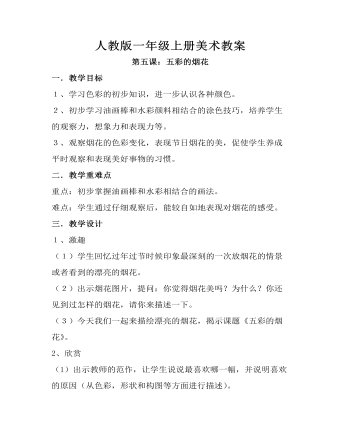
小学美术人教版一年级上册《第5课五彩的烟花》教案
二.教学重难点重点:初步掌握油画棒和水彩相结合的画法。难点:学生通过仔细观察后,能较自如地表现对烟花的感受。三.教学设计1、激趣(1)学生回忆过年过节时候印象最深刻的一次放烟花的情景或者看到的漂亮的烟花。(2)出示烟花图片,提问:你觉得烟花美吗?为什么?你还见到过怎样的烟花,请你来描述一下。(3)今天我们一起来描绘漂亮的烟花,揭示课题《五彩的烟花》。
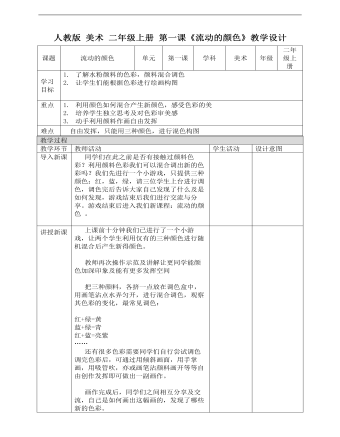
小学美术人教版二年级上册《第1课流动的颜色》教案说课稿
同学们在此之前是否有接触过颜料色彩?利用颜料色彩我们可以混合调出新的色彩吗?我们先进行一个小游戏,只提供三种颜色:红,蓝,绿,请三位学生上台进行调色,调色完后告诉大家自己发现了什么及是如何发现,游戏结束后我们进行交流与分享。游戏结束后进入我们新课程:流动的颜色 。

